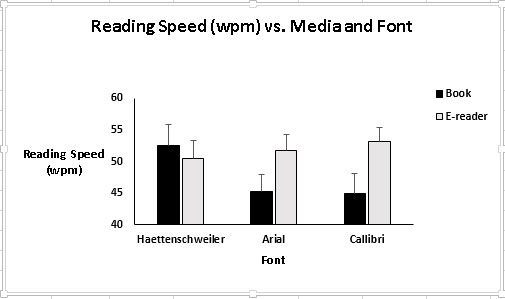
But what should we do if we have two grouping variables? As you’ve probably guessed, we can conduct a two-way ANOVA. A one-way ANOVA is used when we have one grouping variable and a continuous outcome. The post Two-way ANOVA for repeated measures using Python appeared first on Erik Marsja.From learning about the one-way ANOVA, we know that ANOVA is used to identify the mean difference between more than two groups. Also, if you happen to know that you can create nicer plots with Pyvttbl I would also like to know how! Please leave a comment. If you know any other way to do a repeated measures ANOVA using Python please let me know. Also, some corrected degree of freedom and mean square error can be found (e.g., Grenhouse-Geisser corrected).
#How to plot a two way anova in excel 2016 plus
In this table all metrics needed plus some more can be found F-statistic, p-value, mean square errors, confidence intervals, effect size (i.e., eta-squared) for all factors and the interaction.

The output one get from this is an ANOVA table. aov = df.anova('rt', sub='Sub_id', wfactors=) One could, of course combine these techniques, to do a split-plot/mixed ANOVA by adding an argument ‘bfactors’ for the between-subject factor(s).
#How to plot a two way anova in excel 2016 how to
In two previous posts I showed how to carry out one-way and two-way ANOVA for independent measures. To run the Two-Way ANOVA is simple the first argument is the dependent variable, the second the subject identifier, and than the within-subject factors. df.box_plot('rt', factors=)īoxplot Pyvttbl Two-way ANOVA for within-subjects design in Python We get this plot and it is really not that beautiful. As far as I can see there is not much room for changing the plot around. I start with a boxplot using the method boxplot from Pyvttbl. Iv2 = np.concatenate(*(N*len(P))) for q in Q]).tolist()

Iv1 = np.concatenate(*N) for p in P]*len(Q)).tolist() Iv2 could be different levels of distractions (no distraction, synthetic sounds, and speech, for instance). However, you could think of iv1 as two different memory tasks verbal and spatial memory. I was a bit lazy when coming up with the data so I named the independent variables ‘iv1’ and ‘iv2’. As in many of my examples the dependent variable is going to be response time (rt) and we create a list of lists for the different population means we are going to assume (i.e., the variable ‘values’). I create a data set in which we have one factor of two levels (P) and a second factor of 3 levels (Q). I start with importing the Python libraries that are going to be use. In fact, we are going to carry out a Two-way ANOVA but the same method will enable you to analyze any factorial design.

In this post I will extend it into a factorial ANOVA using Python (i.e., Pyvttbl). Previously I have shown how to analyze data collected using within-subjects designs using rpy2 (i.e., R from within Python) and Pyvttbl.


 0 kommentar(er)
0 kommentar(er)
